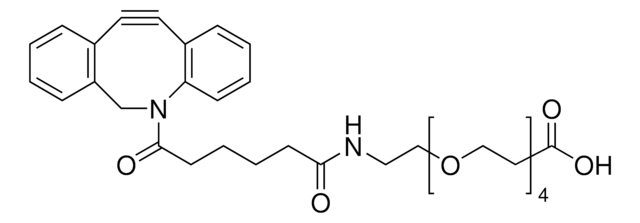If this product has an expiration or retest date, it will be shown on the Certificate of Analysis (COA, CofA). If there is no retest or expiration date listed on the product's COA, we do not have suitable stability data to determine a shelf life. For these products, the only date on the COA will be the release date; a retest, expiration, or use-by-date will not be displayed.
For all products, we recommend handling per defined conditions as printed in our product literature and website product descriptions. We recommend that products should be routinely inspected by customers to ensure they perform as expected.
For products without retest or expiration dates, our standard warranty of 1 year from the date of shipment is applicable.
For more information, please refer to the Product Dating Information document: https://www.sigmaaldrich.com/deepweb/assets/sigmaaldrich/marketing/global/documents/449/386/product-dating-information-mk.pdf
760749
Dibenzocyclooctyne-PEG4-biotin conjugate
for Copper-free Click Chemistry
Sinonimo/i:
Polyethylene glycol, DBCO-PEG4-biotin
Scegli un formato
Scegli un formato
About This Item
Prodotti consigliati
Livello qualitativo
Stato
solid
Impiego in reazioni chimiche
reaction type: click chemistry
Temperatura di conservazione
−20°C
Stringa SMILE
O=C(CCCC[C@@H]1SC[C@@H]2NC(=O)N[C@H]12)NCCOCCOCCOCCOCCC(=O)NCCC(=O)N3Cc4ccccc4C#Cc5ccccc35
InChI
1S/C39H51N5O8S/c45-35(12-6-5-11-34-38-32(28-53-34)42-39(48)43-38)41-18-20-50-22-24-52-26-25-51-23-21-49-19-16-36(46)40-17-15-37(47)44-27-31-9-2-1-7-29(31)13-14-30-8-3-4-10-33(30)44/h1-4,7-10,32,34,38H,5-6,11-12,15-28H2,(H,40,46)(H,41,45)(H2,42,43,48)/t32-,34-,38-/m0/s1
LNHSQAOQVNHUGL-QRBHCBQLSA-N
Categorie correlate
Descrizione generale
Applicazioni
Caratteristiche e vantaggi
Codice della classe di stoccaggio
11 - Combustible Solids
Classe di pericolosità dell'acqua (WGK)
WGK 3
Punto d’infiammabilità (°F)
Not applicable
Punto d’infiammabilità (°C)
Not applicable
Scegli una delle versioni più recenti:
Possiedi già questo prodotto?
I documenti relativi ai prodotti acquistati recentemente sono disponibili nell’Archivio dei documenti.
I clienti hanno visto anche
Articoli
Copper-free click chemistry is an alternative approach to click chemistry that proceeds at a lower activation barrier and is free of cytotoxic transition metal catalysts.
Explore the principles and applications of click chemistry in drug discovery, highlighting efficient reactions that streamline the synthesis of bioactive compounds.
-
How can I determine the shelf life / expiration / retest date of this product?
1 risposta-
Utile?
-
-
How is shipping temperature determined? And how is it related to the product storage temperature?
1 risposta-
Products may be shipped at a different temperature than the recommended long-term storage temperature. If the product quality is sensitive to short-term exposure to conditions other than the recommended long-term storage, it will be shipped on wet or dry-ice. If the product quality is NOT affected by short-term exposure to conditions other than the recommended long-term storage, it will be shipped at ambient temperature. As shipping routes are configured for minimum transit times, shipping at ambient temperature helps control shipping costs for our customers. For more information, please refer to the Storage and Transport Conditions document: https://www.sigmaaldrich.com/deepweb/assets/sigmaaldrich/marketing/global/documents/316/622/storage-transport-conditions-mk.pdf
Utile?
-
Filtri attivi
Il team dei nostri ricercatori vanta grande esperienza in tutte le aree della ricerca quali Life Science, scienza dei materiali, sintesi chimica, cromatografia, discipline analitiche, ecc..
Contatta l'Assistenza Tecnica.












